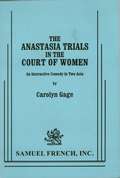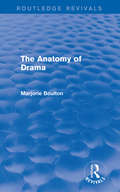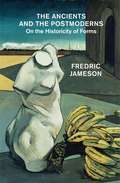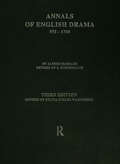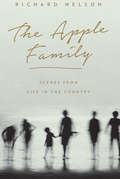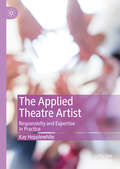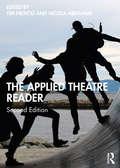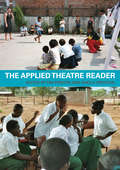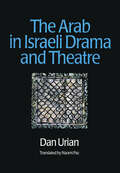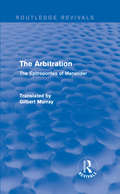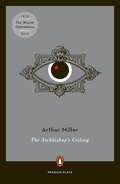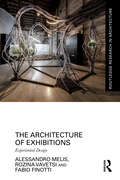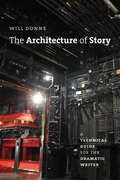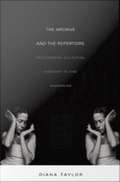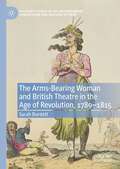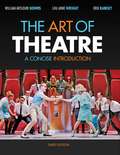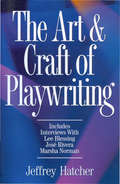- Table View
- List View
The Anastasia Trials In the Court of Women
by Carolyn GageInteractive drama / 9 f / Simple set Audience participation in this courtroom drama creates a profoundly engaging excursion into a world of women who are survivors and abusers. Actually a farcical play within a play, the drama opens as members of a radical feminist theatre group, the Emma Goldman Theatre Brigade, are about to implement their innovative lottery system aimed at insuring equal opportunity for all. They each draw the role they will play on this evening from a hat, putting sisterhood to an iron test. The performance that follows is the conspiracy trial of five women who are accused of denying the defendant Anastasia Romanov her identity. Audience members decide throughout to overrule or sustain the attorneys' motions, creating a different play at every performance.
The Anatomy of Drama (Routledge Revivals)
by Marjorie BoultonThis title, first published in 1960, is intended primarily to increase the understanding of drama among those who do not have easy access to the live theatre and who, therefore, study plays mainly in print. The author’s emphasis is on Shakespeare, but most forms of drama receive some attention. A lucid and lively study of the techniques of plot, dialogue and characterization will help the reader to a deeper appreciated of the problems and successes of the dramatist.
The Ancients and the Postmoderns
by Fredric JamesonFredric Jameson sweeps from the Renaissance to The Wire High modernism is now as far from us as antiquity was for the Renaissance. Such is the premise of Fredric Jameson's major new work in which modernist works, this time in painting (Rubens) and music (Wagner and Mahler), are pitted against late-modernist ones (in film) as well as a variety of postmodern experiments (from SF to The Wire, from "Eurotrash" in opera to Altman and East German literature): all of which attempt, in their different ways, to invent new forms to grasp a specific social totality. Throughout the historical periods, argues Jameson, the question of narrative persists through its multiple formal changes and metamorphoses.From the Hardcover edition.
The Annals of English Drama 975-1700: An Analytical Record Of All Plays, Extant Or Lost, Chronologically Arranged And Indexed By Authors, Titles, Dramatic Companies
by Sylvia Stoler WagonheimAn analytical record of all plays, extinct or lost, chronologically arranged and indexed by authors, titles and dramatic companies.
The Apple Family
by Richard NelsonThis critically acclaimed, searing play cycle about loss, memory and remembrance follows the Apple family of Rhinebeck, NY as they grapple with events both personal and current in the immediate present: the 2010 election (That Hopey Changey Thing), the tenth anniversary of 9/11 (Sweet and Sad), Obama's re-election (Sorry) and the 50th anniversary of JFK's assassination, which premieres in November.
The Applied Theatre Artist: Responsivity and Expertise in Practice
by Kay HepplewhiteThis book analyses the work of applied theatre practitioners using a new framework of ‘responsivity’ to make visible their unique expertise. In-depth investigation of practice combines with theorisation to provide a fresh view of the work of artists and facilitators. Case studies are drawn from community contexts: with women, mental health service users, refugees, adults with a learning disability, older people in care, and young people in school. Common skills and qualities are given a vocabulary to help define applied theatre work, such as awareness, anticipation, adaptation, attunement, and responsiveness. The Applied Theatre Artist is of scholarly, practical, and educational interest. The book offers detailed analysis of how skilled theatre artists make in-action decisions within socially engaged participatory projects. Rich description of in-session activity reveals what workshop facilitators actually do and how they think, offering a rare focus in applied theatre.
The Applied Theatre Reader
by Prentki, Tim / Abraham, NicolaThe Applied Theatre Reader is the first book to bring together new case studies of practice by leading practitioners and academics in the field and beyond, with classic source texts from writers such as Noam Chomsky, bell hooks, Mikhail Bakhtin, Augusto Boal and Chantal Mouffe. This new edition brings the field fully up to date with the breadth of applied theatre practice in the twenty-first century, adding essays on playback theatre, digital technology, work with indigenous practitioners, inter-generational practice, school projects and contributors from South America, Australia and New Zealand. The Reader divides the field into key themes, inviting critical interrogation of issues in applied theatre whilst also acknowledging the multi-disciplinary nature of its subject, crossing fields like theatre in educational settings, prison theatre, community performance, theatre in conflict resolution, interventionist theatre and theatre for development. A new lexicon of Applied Theatre and further reading for every part will equip readers with the ideal tools for studying this broad and varied field. This collection of critical thought and practice is essential to those studying or participating in the performing arts as a means for positive change.
The Applied Theatre Reader
by Tim Prentki Sheila PrestonThe Applied Theatre Reader is the first book to bring together new case studies of practice by leading practitioners and academics in the field and beyond, with classic source texts from writers such as Noam Chomsky, bell hooks, Mikhail Bakhtin, Augusto Boal, and Chantal Mouffe. This book divides the field into key themes, inviting critical interrogation of issues in applied theatre whilst also acknowledging the multi-disciplinary nature of its subject. It crosses fields such as: theatre in educational settings prison theatre community performance theatre in conflict resolution and reconciliation interventionist theatre theatre for development. This collection of critical thought and practice is essential to those studying or participating in the performing arts as a means for positive change.
The Arab in Israeli Drama and Theatre (Contemporary Theatre Studies #Vol. 26)
by Dan UrianWhat is Israeli theatre? Is it only a Hebrew theatre staged in Israel? Are performances by Arab Israelis working in an Arabic theatre framework not part of the repertoire of Israeli theatre? Do they perhaps belong to the Palestinian theatre? What are the "borders" of Palestinian theatre? Are not theatrical works created in East Jerusalem by Arab Israeli playwrights and actors, and staged on occasion before Jewish Israeli audiences, part of a dialogue between Palestinian and Israeli cultures? Does "theatre" only include works staged under that title? These and other similarly absorbing questions arise in Dan Urian's wide-ranging and detailed study of the image of the Arab in Israeli drama and theatre. By the use of extensive examples to show how theatre, politics and personal perceptions intertwine, the author presents us with a model which can be used as a basis for the further discussion and study of similar social and artistic phenomena in other cultures in relation to their theatre and drama.
The Arbitration: The Epitrepontes of Menander (Routledge Revivals)
by Gilbert MurrayGilbert Murray translated and made available to modern readers The Epitrepontes of Menander or The Arbitration for the first time in 1945. The Arbitration is among the most frequently quoted and most famous of Menander’s plays and – being less farcical than others - belongs to his mature style. With an interesting and informative introduction, this translation will be of value to any student of Classics and Ancient Greek drama.
The Archbishop's Ceiling
by Arthur MillerA masterful mix of art, sex, and politics behind the Iron Curtain, by America's greatest dramatist In an unnamed Eastern European capital, four writers gather in what was once an archbishop's palace. There is Adrian, a successful American author struggling with questions about a novel he has set in the city, and Marcus, a once-imprisoned radical who has become a darling of the current regime. Finally, there is Sigmund, perhaps the country's greatest living writer, who refuses to compromise his artistic integrity to appease the regime. Between them all is Maya, a poet and actress who has been a mistress and muse to each man. The ornately decorated ceiling above them may or may not be bugged, and the group carefully watches their words as they discuss the play's central dilemma - should Sigmund stay and resist the oppressive state, or should he defect and pursue his art in freedom? Their conversation poses crucial questions about mass surveillance, morality, and the authenticity of art, and remains as relevant today as it was during the height of the Cold War.
The Architecture of Exhibitions: Experiential Design (Routledge Research in Architecture)
by Alessandro Melis Rozina Vavetsi Fabio FinottiThe Architecture of Exhibitions embarks on a comprehensive exploration of creativity and design innovation within exhibition spaces. It describes the fundamental principles of exhibition design, tracing the origins of creativity and considering its evolutionary significance.The book challenges conventional boundaries imposed by rigid classifications, drawing on heuristic studies in biology and the transformative concept of exaptation. It questions the traditional separations between art, science and technology, which often hinder innovation. By advocating for an interdisciplinary approach, it reimagines creativity that transcends conventional limits. Through practice-based research, multidisciplinary case studies and technological innovations, with a focus on generative AI, the book illustrates how modern exhibition spaces actively engage with their audiences, highlighting their profound impact beyond academic discourse.This book is designed for curators, designers and scholars who are passionate about the future of exhibition spaces. It offers a comprehensive understanding through its four-part structure, making it an essential read for anyone interested in the dynamic interplay between art, technology and society. The book is also designed as an instrument for the education of architecture, design and art students.
The Architecture of Story: A Technical Guide for the Dramatic Writer (Chicago Guides to Writing, Editing, and Publishing)
by Will DunneWhile successful plays tend to share certain storytelling elements, there is no single blueprint for how a play should be constructed. Instead, seasoned playwrights know how to select the right elements for their needs and organize them in a structure that best supports their particular story. Through his workshops and book The Dramatic Writer's Companion, Will Dunne has helped thousands of writers develop successful scripts. Now, in The Architecture of Story, he helps writers master the building blocks of dramatic storytelling by analyzing a trio of award-winning contemporary American plays: Doubt: A Parable by John Patrick Shanley, Topdog/Underdog by Suzan-Lori Parks, and The Clean House by Sarah Ruhl. Dismantling the stories and examining key components from a technical perspective enables writers to approach their own work with an informed understanding of dramatic architecture. Each self-contained chapter focuses on one storytelling component, ranging from "Title" and "Main Event" to "Emotional Environment" and "Crisis Decision." Dunne explores each component in detail, demonstrating how it has been successfully handled in each play and comparing and contrasting techniques. The chapters conclude with questions to help writers evaluate and improve their own scripts. The result is a nonlinear reference guide that lets writers work at their own pace and choose the topics that interest them as they develop new scripts. This flexible, interactive structure is designed to meet the needs of writers at all stages of writing and at all levels of experience.
The Archive and the Repertoire: Performing Cultural Memory in the Americas
by Diana TaylorIn The Archive and the Repertoire preeminent performance studies scholar Diana Taylor provides a new understanding of the vital role of performance in the Americas. From plays to official events to grassroots protests, performance, she argues, must be taken seriously as a means of storing and transmitting knowledge. Taylor reveals how the repertoire of embodied memory--conveyed in gestures, the spoken word, movement, dance, song, and other performances--offers alternative perspectives to those derived from the written archive and is particularly useful to a reconsideration of historical processes of transnational contact. The Archive and the Repertoire invites a remapping of the Americas based on traditions of embodied practice. Examining various genres of performance including demonstrations by the children of the disappeared in Argentina, the Peruvian theatre group Yuyachkani, and televised astrological readings by Univision personality Walter Mercado, Taylor explores how the archive and the repertoire work together to make political claims, transmit traumatic memory, and forge a new sense of cultural identity. Through her consideration of performances such as Coco Fusco and Guillermo Gmez-Pea's show Two Undiscovered Amerindians Visit . . . , Taylor illuminates how scenarios of discovery and conquest haunt the Americas, trapping even those who attempt to dismantle them. Meditating on events like those of September 11, 2001 and media representations of them, she examines both the crucial role of performance in contemporary culture and her own role as witness to and participant in hemispheric dramas. The Archive and the Repertoire is a compelling demonstration of the many ways that the study of performance enables a deeper understanding of the past and present, of ourselves and others.
The Arms-Bearing Woman and British Theatre in the Age of Revolution, 1789-1815 (Palgrave Studies in the Enlightenment, Romanticism and Cultures of Print)
by Sarah BurdettThis book explores shifting representations and receptions of the arms-bearing woman on the British stage during a period in which she comes to stand in Britain as a striking symbol of revolutionary chaos. The book makes a case for viewing the British Romantic theatre as an arena in which the significance of the armed woman is constantly remodelled and reappropriated to fulfil diverse ideological functions. Used to challenge as well as to enforce established notions of sex and gender difference, she is fashioned also as an allegorical tool, serving both to condemn and to champion political and social rebellion at home and abroad. Magnifying heroines who appear on stage wielding pistols, brandishing daggers, thrusting swords, and even firing explosives, the study spotlights the intricate and often surprising ways in which the stage amazon interacts with Anglo-French, Anglo-Irish, Anglo-German, and Anglo-Spanish debates at varying moments across the French revolutionary and Napoleonic campaigns. At the same time, it foregrounds the extent to which new dramatic genres imported from Europe –notably, the German Sturm und Drang and the French-derived melodrama– facilitate possibilities at the turn of the nineteenth century for a refashioned female warrior, whose degree of agency, destructiveness, and heroism surpasses that of her tragic and sentimental predecessors.
The Art Of Theatre: A Concise Introduction
by William Downs Erik Ramsey Lou WrightTHE ART OF THEATRE: A CONCISE INTRODUCTION, Third Edition, explores issues of cultural diversity and creativity, presents a full day-in-the-life of theatre, and offers briefer coverage of theatre history. The authors make timely and relevant connections between theatre and the familiar world of television and film to help students understand how the living art of theatre relates to and influences today's screen entertainment.
The Art and Craft of Playwriting
by Jeffery HatcherJeffrey Hatcher knows the nuts and bolts of writing for the theater. Here, he shares his views on it all--from building tension and plotting a scene, right down to moving a character from one side of the stage to the other. From crafting an intriguing beginning to delivering a satisfying ending.In Hatcher's one-on-one discussions with acclaimed American playwrights Lee Blessing, Marsha Norman and Jose Rivera, you'll find a wealth of practical advice, tricks of the trade and insight that will help you in your own creative efforts.
The Art and Occupation of Stage Design in Finnish Theatres: The Rise and Fall of a Professional Community (ISSN)
by Laura GröndahlThis study explores the formation, establishment, expansion, and disintegration of stage design as a modern profession and a recognized artform in Finnish theatres.Drawing on oral or written recollections and thoughts of stage designers from different decades, the author asks how their artistic agencies, occupational identities, and theoretical self-understanding have been constituted. She analyses Finnish theatre history from new perspectives by shifting the focus from finished performances to largely unknown practices behind the scenes. This book examines the cultural institutions that have constituted the stage designers’ role and position, like the professional city theatre system, the craft union, and education. This research shows how modern and postmodern scenographic innovations have been assimilated to local contexts, and how material and cultural circumstances have reshaped the artistic practices. Without bypassing canonical trendsetters or hegemonic cultural mindsets, the focus is directed on the everyday grassroot level of stage design practices. Personal interviews with over 20 designers make visible an ample repertoire of unwritten knowledge stored in habitual ways of working and dealing creatively with the complex system of theatre making.This book will be of great interest to students and scholars in theatre and performance studies with a focus on scenography.
The Art and Practice of Costume Design
by Melissa L. MerzIn The Art and Practice of Costume Design, a panel of seven designers offer a new multi-sided look at the current state and practice of theatrical costume design. Beginning with an exploration of the role of a Costume Designer, the subsequent chapters analyse and explore the psychology of dress, the principles and elements of design, how to create costume renderings, and collaboration within the production. The book also takes a look at the costume shop and the role of the designer within it, and costume design careers within theatrical and fashion industries.
The Art and Practice of Directing for Theatre
by Paul B. CrookThe formation and communication of vision is one of the primary responsibilities of a director, before ever getting to the nuts and bolts of the process. The Art and Practice of Directing for Theatre helps the young director learn how to discover, harness, and meld the two. Providing both a practical and theoretical foundation for directors, this book explores how to craft an artistic vision for a production, and sparks inspiration in directors to put their learning into practice. This book includes: Guidance through day-to-day aspects of directing, including a director’s skillset and tools, script analysis, and rehearsal structure. Advice on collaborating with production teams and actors, building communication skills and tools, and integrating digital media into these practices. Discussion questions and practical worksheets covering script analysis, blocking, and planning rehearsals, with downloadable versions on a companion website.
The Art and Practice of Directing for Theatre
by Paul B. CrookThe formation and communication of vision is one of the primary responsibilities of a director, before ever getting to the nuts and bolts of the process. The Art and Practice of Directing for Theatre, Second Edition helps the young director learn how to discover, harness, and meld the two.Providing both a practical and theoretical foundation for directors, this book explores how to craft an artistic vision for a production, and sparks inspiration in directors to put their learning into practice. This new edition is fully revised to address changes in theatre since the Covid pandemic, new technology, intimacy direction, and inclusive practices. It features: Guidance through day-to-day aspects of directing, including a director’s skillset and tools, script analysis, and rehearsal structure. Advice on collaborating with production teams and actors, building communication skills and tools, and integrating digital media into these practices. Discussion questions and practical worksheets covering script analysis, blocking, and planning rehearsals. Updated references to reflect the changes in the theatre community and profession since the original writing. Updated examples of studies and technology. This book is written for students in Theatre Directing courses, along with new and aspiring theatrical directors. The Art and Practice of Directing for Theatre, Second Edition includes access to downloadable worksheets, available at www.routledge.com/9781032619514.
The Art of Adaptation: Turning Fact and Fiction Into Film (Owl Books Ser.)
by Linda SegerAdaptations have long been a mainstay of Hollywood and the television networks. Indeed, most Academy Award- and Emmy Award-winning films have been adaptations of novels, plays, or true-life stories. Linda Seger, author of two acclaimed books on scriptwriting, now offers a comprehensive handbook for screenwriters, producers, and directors who want to successfully transform fictional or factual material into film. Seger tells how to analyze source material to understand why some of it resists adaptation. She then gives practical methods for translating story, characters, themes, and style into film. A final section details essential information on how to adapt material and how to protect oneself legally
The Art of Adapting Victorian Literature, 1848-1920: Dramatizing Jane Eyre, David Copperfield, and The Woman in White
by Karen E. LairdIn The Art of Adapting Victorian Literature, 1848-1920, Karen E. Laird alternates between readings of nineteenth-century stage and twentieth-century silent film adaptations to investigate the working practices of the first adapters of Victorian fiction. Laird’s juxtaposition between stage and screen brings to life the dynamic culture of literary adaptation as it developed throughout the long nineteenth-century. Focusing on Charlotte Brontë’s Jane Eyre, Charles Dickens’s David Copperfield, and Wilkie Collins’s The Woman in White, Laird demonstrates how adaptations performed the valuable cultural work of expanding the original novel’s readership across class and gender divides, exporting the English novel to America, and commemorating the novelists through adaptations that functioned as virtual literary tourism. Bridging the divide between literary criticism, film studies, and theatre history, Laird’s book reveals how the Victorian adapters set the stage for our contemporary film adaptation industry.
The Art of Auditioning: Second Edition
by Rob DecinaLearn how to ace your acting audition from a top casting director!Casting Director Rob Decina highlights the difference between the craft of acting and the business of auditioning, and how those two worlds meet in television. Included are proven-effective preparation techniques, including asking the right questions, making specific acting choices, finding beats and beat changes, using spontaneity, and much more. Also included is advice on headshots and resumes and an examination of the difference between audition preparation and theatrical preparation as well as information on how to succeed with self-tape auditions.This updated edition will include both new and updated tips, as well as reflections on the original edition's advice. Rob's career has spanned primetime television, daytime drama, film, to casting for the one of the most prolific television studios for dramas and comedies across network, cable and streaming platforms.
The Art of Broadsword Fighting for Stage and Screen: An Actor’s and Director’s Guide to Staged Violence
by Erick Vaughn WolfeThe Art of Broadsword Fighting for Stage and Screen provides historical and contemporary techniques and styles for the safe training and use of the European broadsword in a theatrical setting.This book starts with a brief breakdown of the history of broadswords, the time periods associated with their use, and the influences of historical masters and their manuscripts. After the brief history section, this book presents the basic techniques of broadsword fighting, starting with grip and body postures. Readers will then move fluidly into the basic actions of cuts, parries, blocks, and disarms. During this process, actors explore the connection between body and weapon and start learning the elements of storytelling through choreography. Special attention is given throughout the text on techniques which need to be approached in a physically and/or mentally safe way by directors, choreographers, performers, teachers, and students. The final chapter focuses on choreographing a fight and utilizing all the material previously covered in this book, with special notes for actors, directors, and teachers about what makes a good fight, how to keep it safe, and how to create the "wow factor" in choreography.The Art of Broadsword Fighting for Stage and Screen is intended for directors, choreographers, actors, students of acting, martial artists, and enthusiasts of stage combat and historical martial arts.
